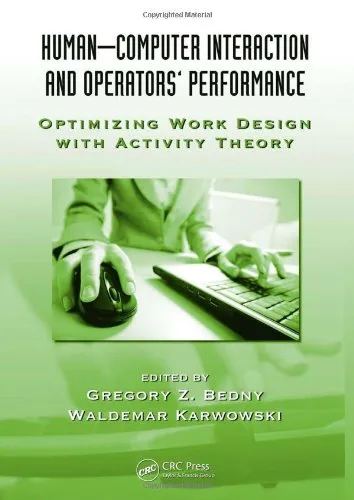Human-Computer Interaction and Operators Performance: Optimizing Work Design with Activity Theory (Ergonomics Design and Management: Theory and Applications)
4.0
بر اساس نظر کاربران

شما میتونید سوالاتتون در باره کتاب رو از هوش مصنوعیش بعد از ورود بپرسید
هر دانلود یا پرسش از هوش مصنوعی 2 امتیاز لازم دارد، برای بدست آوردن امتیاز رایگان، به صفحه ی راهنمای امتیازات سر بزنید و یک سری کار ارزشمند انجام بدینمعرفی کتاب
کتاب Human-Computer Interaction and Operators Performance: Optimizing Work Design with Activity Theory یکی از منابع برجسته در حوزه طراحی کار و بهبود عملکرد کاربران است که از دیدگاه Activity Theory به تحلیل و طراحی سیستمهای تعامل انسان-رایانه میپردازد. این اثر توسط نویسندگان برجسته، گریگوری ز. بدنای و والدمار کاروفسکی، نوشته شده است و رویکردی علمی و کاربردی برای ارگونومی طراحی و مدیریت ارائه میدهد. اگر از متخصصان حوزههای Ergonomics، Human-Computer Interaction (HCI)، تحلیل سیستمهای پیچیده، یا حتی طراحی تجربه کاربری هستید، این کتاب ابزارها و اصولی ارزشمند در اختیار شما قرار میدهد.
خلاصهای از کتاب
این کتاب به بررسی عمیق تعامل میان انسان و سیستمهای رایانهای پرداخته و تلاش میکند تا چارچوبی برای طراحی کارآمدتر و بهینهتر ارائه دهد. نویسندگان از نظریه فعالیت (Activity Theory) بهعنوان چارچوب اصلی خود استفاده کردهاند تا نحوه تعامل کاربران با سیستمها و تأثیر آن بر عملکرد و کارایی مطالعه شود. کتاب به صورت جامع، چگونگی استفاده از مفاهیم مانند Task Analysis، Hierarchical Structure of Activities و کاربرد Dynamic Systems Approach را شرح داده و مثالیهای کاربردی برای درک این اصول ارائه میدهد.
از دیگر موضوعات کلیدی مورد بحث در این کتاب، میتوان به اهمیت عوامل انسانی در طراحی رابطها، طراحی سیستمهای پیچیده تعاملی، و تحلیل روانشناختی فعالیتها اشاره کرد. نویسندگان در این کتاب رویکردی میانرشتهای در پیش گرفتهاند تا مطمئن شوند که خوانندگان از تمام جوانب حیاتی موضوع بهرهمند میشوند.
نکات کلیدی
- تبیین دقیق مفهوم فعالیت در تعاملات انسان-رایانه.
- ارائه چارچوبی جامع برای طراحی کارهای تعاملی با رویکردی مبتنی بر Task Analysis.
- استفاده از Activity Theory برای بهبود کارایی و تولید راهحلهای طراحی انسانمحور.
- تحلیل ساختاری و سلسله مراتبی وظایف و فرآیندها.
- بحث پیرامون اهمیت عوامل انسانی (Human Factors) در طراحی سیستمها.
جملات مشهور از کتاب
"Design must not only focus on efficiency, but also align with the psychological structure of human activities."
"Activity Theory offers a powerful framework to optimize human-computer interaction not only through analysis but also predictive modeling."
چرا این کتاب مهم است؟
اهمیت این کتاب در آن است که یک چشمانداز کاملاً علمی و کاربردی نسبت به طراحی سیستمهای تعاملی ارائه میدهد. استفاده از رویکرد Activity Theory بهعنوان یک چارچوب تعاملی و تجزیهوتحلیل سیستمی آن را به منبعی کمنظیر برای طراحان رابط، مهندسان انسان-رایانه، روانشناسان سازمانی و تحلیلگران کسبوکار تبدیل کرده است. این کتاب با بهرهگیری از روشهای کمی و کیفی نشان میدهد که چگونه میتوان همزمان به بهبود تجربه کاربری و افزایش کارایی سیستمها پرداخت.
علاوه بر این، نویسندگان با استفاده از مثالهای واقعی و شبیهسازیهایی که در کتاب ارائه شدهاند، رابطه بین نظریه و عمل را به خوانندگان نشان میدهند. همین امر باعث شده است که این کتاب همچنان در میان منابع اصلی برای دانشجویان، پژوهشگران و متخصصان مورد اعتماد باشد.
Introduction to "Human-Computer Interaction and Operators Performance: Optimizing Work Design with Activity Theory"
"Human-Computer Interaction and Operators Performance: Optimizing Work Design with Activity Theory" is a groundbreaking exploration into the dynamic interplay between humans and computer systems, emphasizing the importance of optimizing work environments through the lens of Activity Theory. Authored by Gregory Z. Bedny and Waldemar Karwowski, this book serves as a critical resource for human factors engineers, ergonomics practitioners, and designers striving to enhance system performance and workplace efficiency. By combining theoretical insights with practical applications, the book addresses how cognitive, psychological, and operational factors influence human-computer interactions and overall operator performance.
The text revolves around the principles of Activity Theory—a psychological framework that focuses on understanding human actions in context. Leveraging this theory, the authors provide readers with tools to assess and redesign work environments to improve productivity, reduce errors, and minimize mental strain. The book aims to bridge gaps between theory and practice in fields such as HCI (Human-Computer Interaction), cybernetics, work design, and cognitive ergonomics.
Detailed Summary of the Book
The book begins by introducing fundamental concepts from Activity Theory and demonstrates its applicability to the study of human-computer interactions. Activity Theory's systemic approach unveils how operators' mental processes and actions are influenced by their interactions with technology and organizational settings.
Throughout the chapters, the authors methodically dissect activities into hierarchical structures, revealing the relationships among goals, tasks, and operations. They emphasize the importance of understanding human cognitive architecture—memory, problem-solving, attention, and decision-making—as integral to improving operator performance. This is essential for ensuring that software and hardware systems align with user needs and capabilities.
The book balances theoretical depth with practical case studies across various industries where human-computer interaction plays a crucial role. For instance, applications in manufacturing, aviation, and healthcare illustrate how optimized work design can prevent errors and improve safety. By correlating human error theories to interaction frameworks, the authors pave the way for innovative solutions to real-world challenges.
Moreover, the book delves into dynamic systems analysis, which evaluates how operators adapt to changes in technology, organizational goals, and external factors. It provides concrete methodologies for assessing work systems and redesigning tasks to enhance human and machine collaboration.
Key Takeaways
- Activity Theory serves as a robust framework for analyzing complex systems involving human-computer interaction.
- A deeper understanding of operators' cognitive processes can lead to more effective and user-friendly system designs.
- Work optimization requires an interdisciplinary approach, combining psychology, ergonomics, and systems engineering.
- Real-world case studies demonstrate the practicality of the methods outlined in the book.
- The integration of dynamic systems theory ensures adaptability in rapidly changing technological landscapes.
Famous Quotes from the Book
"Work is not simply a series of tasks; it is a dynamic interplay of cognitive strategies, tools, and environmental conditions."
"The true efficiency of any system lies in its ability to adapt to human variability."
Why This Book Matters
"Human-Computer Interaction and Operators Performance" is essential reading for professionals and researchers aiming to navigate the complexities of modern work systems. As technology becomes increasingly integrated into everyday tasks, the need to harmonize human potential with technological capabilities has grown exponentially.
This book provides a structured approach to designing systems that are not only efficient but also user-centered and adaptable. By exploring the foundations of Activity Theory and presenting actionable recommendations, the authors empower readers to rethink traditional approaches to workplace ergonomics and HCI.
Whether you are a system designer, an ergonomist, or an academic in the fields of cognitive science or human factors, this book equips you with the knowledge and tools to ensure that technology serves its ultimate purpose: enhancing human performance and well-being.
دانلود رایگان مستقیم
You Can Download this book after Login
دسترسی به کتابها از طریق پلتفرمهای قانونی و کتابخانههای عمومی نه تنها از حقوق نویسندگان و ناشران حمایت میکند، بلکه به پایداری فرهنگ کتابخوانی نیز کمک میرساند. پیش از دانلود، لحظهای به بررسی این گزینهها فکر کنید.
این کتاب رو در پلتفرم های دیگه ببینید
WorldCat به شما کمک میکنه تا کتاب ها رو در کتابخانه های سراسر دنیا پیدا کنید
امتیازها، نظرات تخصصی و صحبت ها درباره کتاب را در Goodreads ببینید
کتابهای کمیاب یا دست دوم را در AbeBooks پیدا کنید و بخرید
1193
بازدید4.0
امتیاز50
نظر98%
رضایتنظرات:
4.0
بر اساس 0 نظر کاربران
"کیفیت چاپ عالی بود، خیلی راضیام"


